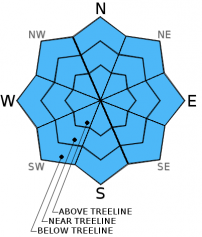| Thursday | Thursday Night | Friday | |
|---|---|---|---|
| Weather: | Partly cloudy becoming mostly cloudy | Mostly cloudy with a slight chance of rain showers after midnight | Cloudy with a chance of rain showers in the morning and rain likely in the afternoon |
| Temperatures: | 54 to 61 deg. F. | 31 to 38 deg. F. | 49 to 55 deg. F. |
| Mid Slope Winds: | East | Southwest | Variable |
| Wind Speed: | 10 to 15 mph | 10 to 15 mph with gusts to 25 mph after midnight | Light |
| Expected snowfall: | 0 | 0 | Rain: up to .3 |
| Thursday | Thursday Night | Friday | |
|---|---|---|---|
| Weather: | Partly cloudy becoming mostly cloudy | Mostly cloudy with a slight chance of showers after midnight | Cloudy with a chance of rain and snow showers in the morning and rain and snow likely in the afternoon. Snow levels around 9000 ft. |
| Temperatures: | 50 to 57 deg. F. | 31 to 38 deg. F. | 41 to 48 deg. F. |
| Ridge Top Winds: | East | Southwest | South shifting to southwest in the afternoon |
| Wind Speed: | 15 to 25 mph with gusts to 40 mph | 20 to 30 mph with gusts to 35 mph increasing to 45 mph after midnight | 20 to 25 mph with gusts to 40 mph decreasing to 10 to 15 mph in the afternoon |
| Expected snowfall: | 0 | 0 | Mostly rain with upper elevation snow up to 3 |























